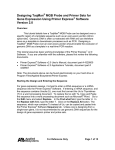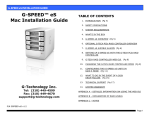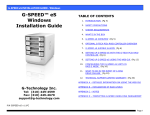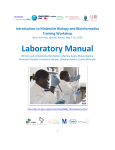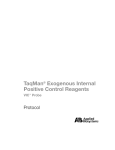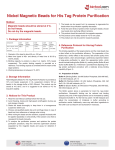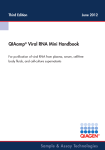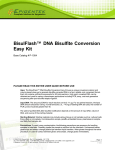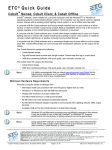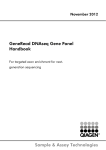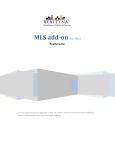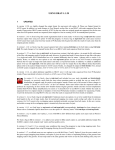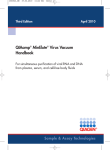Download GeneRead DNA FFPE Handbook
Transcript
March 2014 GeneRead™ DNA FFPE Handbook For purification of genomic DNA from formalin-fixed, paraffin-embedded (FFPE) tissues for reliable next-generation sequencing analysis Making improvements in life possible® Sample & Assay Technologies QIAGEN Sample and Assay Technologies QIAGEN is the leading provider of innovative sample and assay technologies, enabling the isolation and detection of contents of any biological sample. Our advanced, high-quality products and services ensure success from sample to result. QIAGEN sets standards in: Purification of DNA, RNA, and proteins Nucleic acid and protein assays microRNA research and RNAi Automation of sample and assay technologies Our mission is to enable you to achieve outstanding success and breakthroughs. For more information, visit www.qiagen.com. Contents Kit Contents 4 Storage 4 Intended Use 5 Safety Information 5 Quality Control 6 Introduction 7 Principle and procedure 7 Automated purification 9 Equipment and Reagents to Be Supplied by User 10 Important Notes 11 Starting material 11 Preparation of buffers 11 Protocol: Purification of DNA from FFPE Samples 13 Troubleshooting Guide 16 Ordering Information 18 GeneRead DNA FFPE Handbook 03/2014 3 Kit Contents GeneRead DNA FFPE Kit Catalog no. (50) 180134 Number of preps 50 QIAamp MinElute® Columns 50 Collection Tubes (2 ml) Deparaffinization Solution 1 x 50 1 x 8 ml Buffer FTB 2 x 0.8 ml Buffer AL* 33 ml Proteinase K 1.25 ml Buffer AW1*† (concentrate) 19 ml Buffer AW2†‡ (concentrate) 13 ml Uracil-N-glycosylase 2 x 1 ml RNase-Free Water 10 ml RNase A (100mg/ml) 14 mg Buffer ATE‡ 12 ml Quick-Start Protocol 1 *CAUTION: Contains a chaotropic salt. Take appropriate laboratory safety measures and wear gloves when handling. Not compatible with disinfectants containing bleach. See “Safety Information”, page 5. † Before using for the first time, add ethanol (96–100%) as indicated on the bottle to obtain a working solution. ‡ Contains sodium azide as a preservative. Storage Uracil-N-glycosylase is shipped on dry ice. The product should be stored immediately upon receipt at –20°C in a constant-temperature freezer. When the product is stored under these conditions and handled correctly, performance is guaranteed until the expiration date (see the quality control label on the tube). QIAamp MinElute columns should be stored at 2–8°C upon arrival and are stable under these conditions for at least one year after delivery. However, 4 GeneRead DNA FFPE Handbook 03/2014 short-term storage of up to 4 weeks at room temperature (15–25°C) does not affect performance. The GeneRead DNA FFPE Kit contains a ready-to-use Proteinase K solution, which is supplied in a specially formulated storage buffer. Proteinase K is stable for at least one year after delivery when stored at room temperature (15–25°C). For storage for >1 year, or if ambient temperatures often exceed 25°C, we suggest storing Proteinase K at 2–8°C. The remaining kit components can be stored at room temperature (15–25°C) for up to 12 months without showing any reduction in performance and quality. Check buffers for precipitate before use and redissolve at 30–70°C if necessary. Intended Use The GeneRead DNA FFPE Kit is intended for molecular biology applications. This product is not intended for the diagnosis, prevention, or treatment of a disease. All due care and attention should be exercised in the handling of the products. We recommend all users of QIAGEN® products to adhere to the NIH guidelines that have been developed for recombinant DNA experiments, or to other applicable guidelines. Safety Information When working with chemicals, always wear a suitable lab coat, disposable gloves, and protective goggles. For more information, please consult the appropriate safety data sheets (SDSs). These are available online in convenient and compact PDF format at www.qiagen.com/safety where you can find, view, and print the SDS for each QIAGEN kit and kit component. CAUTION: DO NOT add bleach or acidic solutions directly to the sample preparation waste. Buffer AL and Buffer AW1 contain guanidine hydrochloride, which can form highly reactive compounds if combined with bleach. If liquid containing these buffers is spilt, clean with suitable laboratory detergent and water. If the spilled liquid contains potentially infectious agents, clean the affected area first with laboratory detergent and water, and then with 1% (v/v) sodium hypochlorite. GeneRead DNA FFPE Handbook 03/2014 5 24-hour emergency information Chemical emergency or accident assistance is available 24 hours a day from: CHEMTREC USA & Canada Tel: 1-800-424-9300 Outside USA & Canada Tel: +1-703-527-3887 (collect calls accepted) Quality Control In accordance with QIAGEN’s ISO-certified Quality Management System, each lot of the GeneRead DNA FFPE Kit is tested against predetermined specifications to ensure consistent product quality. 6 GeneRead DNA FFPE Handbook 03/2014 Introduction DNA preparation from FFPE tissue for next-generation sequencing applications is associated with several challenges. Yields are often limited due to the precious nature of the sample and the compromised status of the DNA. Additionally, artifacts introduced by fixation and embedding conditions, and due to long-term storage, are most prevalent in sequencing results when starting with limited material. One particular problem is the deamination of cytosine bases to deoxyuracil. This leads to a C-T conversion in sequencing reactions. The GeneRead DNA FFPE Kit provides a streamlined procedure for efficient purification of high yields of DNA from small amounts of FFPE tissue sections. Additionally, the procedure includes the removal of deaminated cytosine to prevent false results in DNA sequencing. Principle and procedure The GeneRead DNA FFPE procedure removes paraffin and reverses formalin cross-links from the DNA sample before it is bound to the QIAamp MinElute column. After heating to remove cross-links, the DNA is accessible for the specific removal of deaminated cytosine residues by the enzyme Uracil-NGlycosilase (UNG). The optimized reaction mixture provides conditions in which the UNG can specifically remove artificially-induced uracils from the DNA obtained from the FFPE sample. After the binding of DNA to the spin column, residual contaminants such as salts are washed away by Buffers AW1 and AW2, and ethanol. Any residual ethanol, which may interfere with subsequent enzymatic reactions, is removed by an additional centrifugation step. DNA is eluted and is now ready to use in next-generation sequencing workflows. Alternatively, it can be stored at –20°C. GeneRead DNA FFPE Handbook 03/2014 7 GeneReead DNA FFPE procedure Dig gest artifacts 8 Gen neRead DNA FFPE Hanndbook 03/2014 Autom mated purificatio on The Ge eneRead DNA D FFPE E Kit can b be automa ated on the e QIAcubee®. The innova ative QIAcube uses advanced a d technolog gy to proc cess QIAG GEN spin column ns, enablin ng seamle ess integra ation of au utomated, low-throug ghput sam mple prep in nto your la aboratory workflow . Sample preparatio on using thhe QIAcube followss the same e steps as the manua b was h, and elu ute) al procedure (i.e., bind, enablin ng purifica ation of hiigh-qualityy DNA. Th he QIAcub be is preinnstalled wiith protoco ols for purrification of o plasmid d DNA, ge enomic DN NA, RNA,, viral nucleic acids, and prote eins, plus DNA D and RNA clea anup. The range of protocols ble is conttinually ex xpanding, and addiitional QIA AGEN pro otocols can be availab downlo oaded free e of charg ge at www w.qiagen.ccom/MyQ QIAcube. The Q QIAcube. IMPOR RTANT: De epending on o the freq quency off QIAcube e usage, a dditional RNase e A may ha ave to be ordered. GeneRe ead DNA FFPE Handbo ook 03/20 014 9 Equipment and Reagents to Be Supplied by User When working with chemicals, always wear a suitable lab coat, disposable gloves, and protective goggles. For more information, consult the appropriate safety data sheets (SDSs), available from the product supplier. Ethanol (96–100%). Do not use denatured alcohol, which contains other substances such as methanol or methylethylketone. 1.5 ml Safe-Lock microcentrifuge tubes (available from Brinkmann, cat. no. 022363204, or Eppendorf, cat. no. 0030 120.086), or 1.5 ml SafeSeal microcentrifuge tubes (Sarstedt, cat. no. 72.706)* or 2 ml Safe-Lock microcentrifuge tubes (available from Brinkmann, cat. no. 022363352, or Eppendorf, cat. no. 0030 120.094), or 2 ml SafeSeal microcentrifuge tubes (Sarstedt, cat. no. 72.695)* Pipet and pipet tips (to avoid cross-contamination, we recommend pipet tips with aerosol barriers) Thermomixer or heating block capable of incubation at 90°C Microcentrifuge with rotor for 2 ml tubes Vortexer * This is not a complete list of suppliers and does not include many important vendors of biological supplies. 10 GeneRead DNA FFPE Handbook 03/2014 Important Notes Starting material Standard formalin-fixation and paraffin-embedding procedures always result in significant fragmentation of nucleic acids. To limit the extent of DNA fragmentation, be sure to: Fix tissue samples in 4–10% formalin as quickly as possible after surgical removal. Use a fixation time of 14–24 hours (longer fixation times lead to more severe DNA fragmentation, resulting in poor performance in downstream assays). Thoroughly dehydrate samples prior to embedding (residual formalin can inhibit proteinase K digestion). Starting material for DNA purification should be a freshly cut section of FFPE tissue, with a thickness of up to 10 μm. Usually, DNA yields from this amount of material exceed 0.5 μg, which is enough for NGS downstream applications. However, DNA yield from FFPE samples varies greatly, depending on the tissue type, as well as fixation and embedding conditions. Always analyze yields precisely before proceeding. Avoid using too much starting material, as this severely affects the performance of the GeneRead DNA FFPE Kit. Preparation of buffers Preparing Buffer FTB Precipitates may form in Buffer FTB. Make sure all precipitates are dissolved at 30°C. Preparing Buffer AL Before starting the procedure, check whether precipitate has formed in Buffer AL. If necessary, dissolve by heating to 70°C with gentle agitation. Preparing Buffer AW1 Add 25 ml ethanol (96–100%) to the bottle containing 19 ml Buffer AW1 concentrate. Tick the check box on the bottle label to indicate that ethanol has been added. GeneRead DNA FFPE Handbook 03/2014 11 Reconstituted Buffer AW1 can be stored at room temperature (15–25°C) for up to 1 year. Note: Before starting the procedure, mix reconstituted Buffer AW1 by shaking. Preparing Buffer AW2* Add 30 ml ethanol (96–100%) to the bottle containing 13 ml Buffer AW2 concentrate. Tick the check box on the bottle label to indicate that ethanol has been added. Reconstituted Buffer AW2 can be stored at room temperature (15–25°C) for up to1 year. Note: Before starting the procedure, mix reconstituted Buffer AW2 by shaking. * Contains sodium azide as a preservative. 12 GeneRead DNA FFPE Handbook 03/2014 Protocol: Purification of DNA from FFPE Samples This protocol is for the purification of genomic DNA from formalin-fixed, paraffin-embedded tissues, ready for reliable next-generation sequencing analysis. Important points before starting Perform all centrifugation steps at room temperature (15–25°C). Read “Important Notes”, page 11. Things to do before starting Equilibrate all buffers to room temperature (15–25°C). Set a thermomixer or heating block to 56°C for use in step 5 and 8. If possible, preheat a second thermomixer or heating block to 90°C for use in step 9 and a third to 50°C for use in step 12. Precipitates may form in Buffer FTB. Make sure all precipitates are dissolved at 30°C. If Buffer AL contains precipitates, dissolve by heating to 70°C with gentle agitation. Deparaffinization Solution solidifies at temperatures below 18°C. Incubate at 30°C to liquefy. Before starting the procedure, mix reconstituted Buffer AW1 and AW2 by shaking. Procedure 1. Using a scalpel, trim excess paraffin off the sample block. 2. Cut one section up to 10 μm thick (see “Starting material”, page 11). If the sample surface has been exposed to air, discard the first 2–3 sections. 3. Immediately place the section in a 1.5 ml or 2 ml microcentrifuge tube (not supplied). 4. Add 160 μl Deparaffinization Solution, vortex vigorously for 10 s, and centrifuge briefly to bring the sample to the bottom of the tube. 5. Incubate at 56°C for 3 min, and then allow to cool at room temperature. If too little Deparaffinization Solution is used or if too much paraffin is carried over with the sample, Deparaffinization Solution may become waxy or solid after cooling. If this occurs, add additional Deparaffinization Solution and repeat the 56°C incubation. 6. Add 55 μl RNase-free water, 25 μl Buffer FTB, and 20 μl proteinase K. GeneRead DNA FFPE Handbook 03/2014 13 Note: A master mix comprising RNase-free water, Buffer FTB, and proteinase K may be prepared in advance. 7. Vortex and briefly centrifuge the samples. Note: Deparaffinization Solution will form a layer above Buffer FTB with the addition of proteinase K. 8. Incubate at 56°C for 1 h Note: If using only one thermomixer or heating block, leave the sample at room temperature (15–25°C) after the 56°C incubation in step 8, until the thermomixer or heating block has reached 90°C for step 9. 9. Incubate at 90°C for 1 h. Incubation at 90°C in Buffer FTB partially reverses formaldehyde modification of nucleic acids. Longer incubation times or higher incubation temperatures may result in more fragmented DNA. Note: If using only one thermomixer or heating block, leave the sample at room temperature (15–25°C) after the 90°C incubation in step 9, until the thermomixer or heating block has reached 50°C for step 12. 10. Briefly centrifuge the tube to remove drops from inside the lid. 11. Transfer the lower, clear phase into a new microcentrifuge tube (not provided), add 115 μl RNase-free water, and mix. 12. Add 35 μl UNG to the sample, vortex, and incubate at 50°C for one hour in a thermomixer or heating block. 13. Briefly centrifuge the tube to remove drops from inside the lid. 14. Add 2 μl RNase A (100 mg/ml), mix, and incubate for 2 min at room temperature. 15. Add 250 μl Buffer AL to the sample, and mix thoroughly by vortexing. Then add 250 μl ethanol (96–100%) to the sample and mix again thoroughly by vortexing. Centrifuge briefly to remove drops from inside the lid. 16. Transfer 700 μl lysate to the QIAamp MinElute column (in a 2 ml collection tube) without wetting the rim, close the lid, and centrifuge at maximum speed for 1 min. Discard the flow-through* and reuse the collection tube. If the lysate has not completely passed through the membrane after centrifugation, centrifuge again at a higher speed until the QIAamp MinElute column is empty. 17. Repeat step 16 until the complete lysate is used. * Flow-through contains Buffer AL or AW1 and is therefore not compatible with bleach. See page 5 for safety information. 14 GeneRead DNA FFPE Handbook 03/2014 18. Add 500 μl Buffer AW1 to the spin column and centrifuge at maximum speed for 1 min. Discard the flow-through* and reuse the collection tube. 19. Add 500 μl Buffer AW2 to the spin column and centrifuge at maximum speed for 1 min. Discard the flow-through and reuse the collection tube. 20. Add 250 μl ethanol (96–100%) to the spin column and centrifuge at maximum speed for 1 min. Discard the flow-through and the collection tube. 21. Place the spin column into a new 2 ml collection tube (supplied), and centrifuge at maximum speed for 1 min to remove any residual liquid. 22. Place the QIAamp MinElute column in a clean 1.5 ml microcentrifuge tube (not provided), and discard the collection tube containing the flow-through. Carefully open the lid of the QIAamp MinElute column and apply 20– 40 μl Buffer ATE to the center of the membrane. IMPORTANT: Ensure that Buffer ATE is equilibrated to room temperature. Dispense Buffer ATE onto the center of the membrane to ensure complete elution of bound DNA. The volume of eluate will be up to 5 μl less than the volume of elution solution applied to the column. 23. Close the lid and incubate at room temperature for 1 min. Centrifuge at maximum speed (20,000 x g or14,000 rpm) for 1 min. Note: Incubating the QIAamp MinElute column loaded with Buffer ATE for 5 min at room temperature before centrifugation generally increases DNA yield. * Flow-through contains Buffer AL or AW1 and is therefore not compatible with bleach. See page 5 for safety information. GeneRead DNA FFPE Handbook 03/2014 15 Troubleshooting Guide This troubleshooting guide may be helpful in solving any problems that may arise. For more information, see also the Frequently Asked Questions page at our Technical Support Center: www.qiagen.com/FAQ/FAQList.aspx. The scientists in QIAGEN Technical Services are always happy to answer any questions you may have about either the information and protocols in this handbook or sample and assay technologies (for contact information, see back cover or visit www.qiagen.com). Comments and suggestions Little or no DNA in the eluate a) Poor quality of starting material Samples that were fixed for over 20 hours or stored for very long periods of time may contain very little usable nucleic acids. Sections that were mounted on microscope slides may yield very little usable nucleic acids due to prolonged exposure to air. b) Low percentage ethanol used instead of 96–100% ethanol Repeat the purification procedure with new samples using 96–100% ethanol. Do not use denatured ethanol as described on page 10. c) Buffer AW1 or Buffer AW2 prepared incorrectly Make sure that Buffer AW1 or Buffer AW2 concentrates were diluted with the correct volume of 96–100% ethanol, as described on page 10. d) DNA still bound to spin column Repeat the elution step, but incubate the QIAamp MinElute spin column on the benchtop for 10 min with Buffer ATE before centrifuging. Inefficient removal of deaminated cytosine a) Too much starting material Since the GeneRead DNA FFPE Kit is based on an enzymatic digestion, too much starting material will lead to inefficiency. Reduce the amount of starting material. b) UNG reaction mixture prepared incorrectly Be sure to properly prepare the reaction mix by precise addition of all components and transfer of the aqueous phase in steps 6 and 11. 16 GeneRead DNA FFPE Handbook 03/2014 Comments and suggestions Clogged QIAamp MinElute spin column Centrifugation temperature too low The centrifugation temperature should be 15– 25°C. Some centrifuges may cool to below 15°C even when set at 20°C. This can cause formation of precipitates that can clog the QIAamp MinElute spin column. If this happens, set the centrifugation temperature to 25°C. Warm the ethanol-containing sample to 37°C before transferring it to the QIAamp mini spin column. GeneRead DNA FFPE Handbook 03/2014 17 Ordering Information Product Contents Cat. no. GeneRead DNA FFPE Kit (50) For 50 preps: QIAamp MinElute Columns, Collection Tubes, Deparaffinization Solution, Uracil-Nglycosylase, RNase-Free Water, RNase A, and Buffers 180134 Accessories and reagents Deparaffinization Solution (16 ml) 2 x 8 ml deparaffinization solution 19093 QIAGEN Proteinase K (2 ml) 2 ml (>600 mAU/ml, solution) 19131 Collection Tubes (2 ml) 1000 Collection Tubes (2 ml) 19201 RNase A (17,500 U) 2.5 ml (100 mg/ml; 7000 units/ml, solution) 19101 QIAcube — for fully automated sample preparation using QIAGEN spin-column kits QIAcube (110 V)† QIAcube (230 V)‡1 Robotic workstation for automated purification of nucleic acids or proteins using QIAGEN spin-column kits, 1-year warranty on parts and labor§ 9001292† 9001293‡ * Fully automatable on the QIAcube. See www.qiagen.com/MyQIAcube for protocols. † US, Canada, and Japan. ‡ Rest of world. § Agreements for comprehensive service coverage are available; please inquire. 18 GeneRead DNA FFPE Handbook 03/2014 Product Contents Cat. no. Starter Pack, QIAcube* Pack includes: reagent bottle racks (3); rack labeling strips (8); 200 μl filter-tips (1024); 1000 μl filter-tips (1024); 1000 μl filter-tips, wide-bore (1024); 30 ml reagent bottles (18); rotor adapters (120); rotor adapter holder 990395 For up-to-date licensing information and product-specific disclaimers, see the respective QIAGEN kit handbook or user manual. QIAGEN kit handbooks and user manuals are available at www.qiagen.com or can be requested from QIAGEN Technical Services or your local distributor. * US, Canada, and Japan. GeneRead DNA FFPE Handbook 03/2014 19 Trademarks: QIAGEN®, QIAamp®, QIAcube®, GeneRead™, Making improvements in life possible®, MinElute® (QIAGEN Group). Limited License Agreement for the GeneRead DNA FFPE Kit Use of this product signifies the agreement of any purchaser or user of the product to the following terms: 1. The product may be used solely in accordance with the protocols provided with the product and this handbook and for use with components contained in the kit only. QIAGEN grants no license under any of its intellectual property to use or incorporate the enclosed components of this kit with any components not included within this kit except as described in the protocols provided with the product, this handbook, and additional protocols available at www.qiagen.com. Some of these additional protocols have been provided by QIAGEN users for QIAGEN users. These protocols have not been thoroughly tested or optimized by QIAGEN. QIAGEN neither guarantees them nor warrants that they do not infringe the rights of third-parties. 2. Other than expressly stated licenses, QIAGEN makes no warranty that this kit and/or its use(s) do not infringe the rights of third-parties. 3. This kit and its components are licensed for one-time use and may not be reused, refurbished, or resold. 4. QIAGEN specifically disclaims any other licenses, expressed or implied other than those expressly stated. 5. The purchaser and user of the kit agree not to take or permit anyone else to take any steps that could lead to or facilitate any acts prohibited above. QIAGEN may enforce the prohibitions of this Limited License Agreement in any Court, and shall recover all its investigative and Court costs, including attorney fees, in any action to enforce this Limited License Agreement or any of its intellectual property rights relating to the kit and/or its components. For updated license terms, see www.qiagen.com. © 2014 QIAGEN, all rights reserved. www.qiagen.com Australia [email protected] Austria [email protected] Belgium [email protected] Brazil [email protected] Canada [email protected] China [email protected] Denmark [email protected] Finland [email protected] France [email protected] Germany [email protected] Hong Kong [email protected] India [email protected] Ireland [email protected] Italy [email protected] Japan [email protected] Korea (South) [email protected] Luxembourg [email protected] Mexico [email protected] The Netherlands [email protected] Norway [email protected] Singapore [email protected] Sweden [email protected] Switzerland [email protected] UK [email protected] USA [email protected] 1075600 03/2014 Sample & Assay Technologies





















